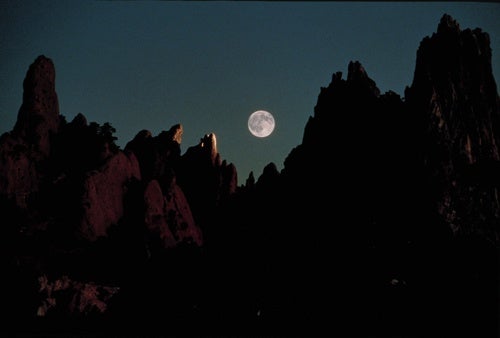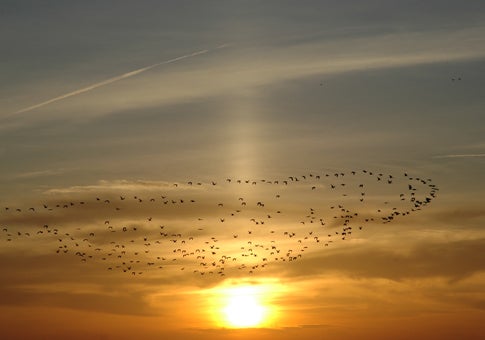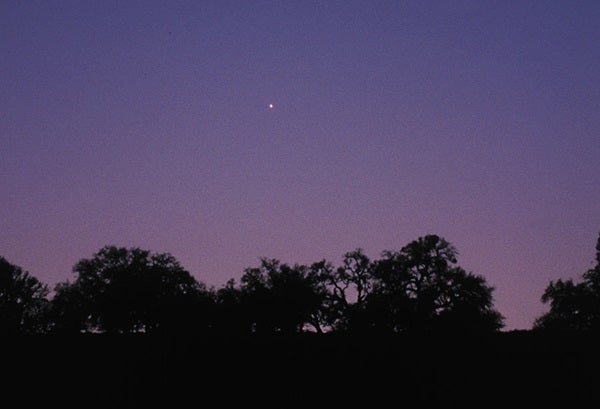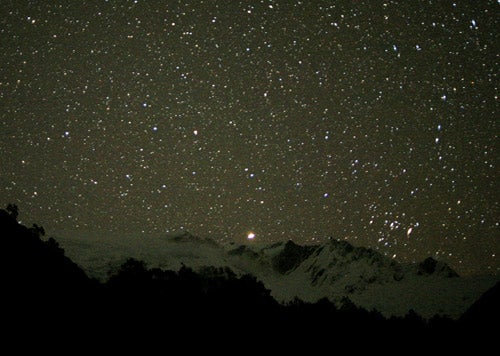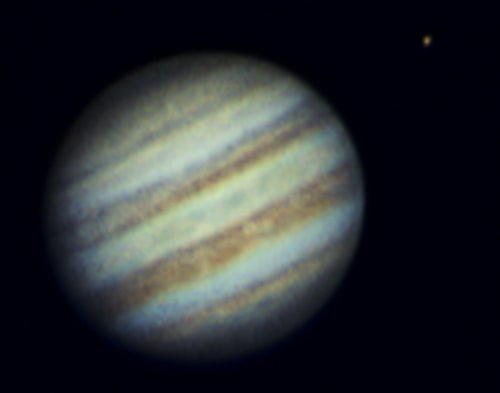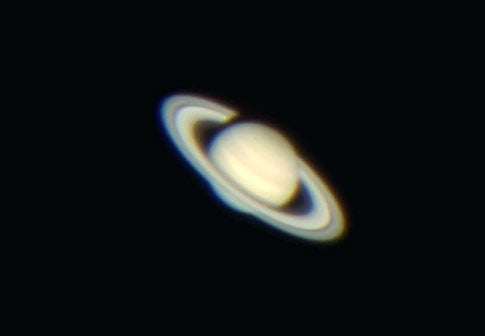But all is not necessarily paradise in metropolis. Even though light pollution may not impact planetary observing, concrete jungles can be full of localized sources of heat, which lead to turbulent seeing conditions and blurry views. Roadways, parking lots, and the buildings themselves all absorb heat during the day, only to radiate it back at night. That can be a problem. But at the same time, the haze that often engulfs cities can actually calm atmospheric instability. The area around Miami, for instance, is famous for its steady skies.
Here are some tricks and tips to make exploring the solar system from your location more enjoyable. Let’s begin by looking a little closer at the choice of observing site. Planet viewing depends more on the steadiness of the atmosphere than it does on darkness and transparency. Because roofs, driveways, and other paved surfaces soak up a disproportionately large amount of heat during the day, they are usually among the worst choices for viewing the planets.
Grassy areas absorb relatively little heat, making them far better options. But even then, shy away from setting up near leafy trees. As Jeff Barton from Dallas writes, “I use two oak trees to block light pollution to the west and my house to block lights to the east, giving me a fairly good view due south. I notice, however, that as a planet rises above the oaks, the heat from those trees obliterates detail no matter how good the transparency and seeing are otherwise.” Wind direction and speed may help or hinder. Setting up on the upwind side of a heat source often lessens its impact on seeing, because the radiating heat will be diverted away from you.
No matter where you are, the Moon never fails to please. With one glance, you’re instantly transported into lunar orbit. Dark maria, towering mountains, and all those craters appear so close, it almost feels like you can reach out and touch them.
With a detailed Moon map in hand, you can survey our nearest space neighbor in amazing detail. Antonin Rukl’s Atlas of the Moon is the best lunar atlas in print, while Patrick Chevalley and Christian Legrand’s freeware Virtual Moon Atlas is a great program for creating customized charts.
Each lunar phase holds something exciting for the sightseeing astronomer. The crescent phases after New Moon through First Quarter display a tremendous variety of lunar terrain. Dominating the equatorial zone are the vast expanses of the lunar seas Maria Crisium, Fecunditatis, Tranquilitatis, and Serenitatis. Many large craters are scattered to their north, while the South Polar Region is awe-inspiring in its coarse beauty. Of special interest there are the craters Clavius and Tycho, both of which see sunrise the night after First Quarter.
After First Quarter, sunlight slowly pours into Oceanus Procellarum. The largest of all lunar maria, the Ocean of Storms holds many wondrous sights, including the craters Copernicus and Kepler. To the north, the crater remnant Sinus Iridum and the unusual dark-floored crater Plato receive first light. To the south, Tycho seems ablaze as its magnificent system of bright rays scatters beyond the Moon’s equator. Once Full Moon passes, the sequence reverses, with shadowing and lighting effects adding a different perspective to our neighbor.
As the Moon tracks across the sky, it will often pass in front of, or occult, stars. On rare occasions, it will occult a planet. Watching the Moon slowly cross in front of another celestial object can be a lot of fun, as well as a useful scientific activity. By knowing the exact moment of disappearance or reappearance of a star or planet, scientists may detect slight fluctuations in the Moon’s orbital distance and speed. It is also possible to determine if the occulted star is single or an unresolved double.
Occultations of brighter stars and planets are always fun to watch. Find a year’s worth of upcoming occultations published in the Royal Astronomical Society of Canada’s annual Observer’s Handbook. Lunar eclipses are also great to watch from any location. All you need is a good view of the Moon. Information and tips about upcoming eclipses are also available in Astronomy as well as in my book Eclipse! (John Wiley & Sons, 1997).
Related video: Observe the Moon with a small telescope — Follow a few easy tips, and you’ll be an experienced moonwatcher in no time.
Before discussing what to look for, it is critically important to emphasize how to look at the Sun. Direct exposure to sunlight will burn the retinas of your eyes quickly when concentrated through a telescope or binoculars. Without taking proper safety precautions, looking at the Sun can cause permanent eye damage, even blindness.
Regardless of type, a solar filter must be mounted securely in front of the telescope or binoculars before looking through the eyepiece. This way, the dangerously intense light and heat from the Sun are reduced to safe levels before entering the optics and your eyes. Never place a solar filter between the eyepiece and your eyes. The concentrated solar heat can quickly crack glass filters or burn through thin Mylar film.
One of the most interesting solar observations is to monitor the fluctuating number of sunspots across the Sun’s photosphere. Sunspots appear at disturbed areas in the Sun’s powerful magnetic field. Each spot consists of a black central portion, called the umbra, and a surrounding grayish area, called the penumbra. They may range in size from hundreds to thousands of miles in diameter. Try to draw the Sun’s disk every second or third day over a span of a month or more. With each successive sketch, sunspots will be seen to come and go, changing size and shape as they travel across the solar disk.
Bob Godfrey has become a one-star astronomer in recent years, in part because of the level of light pollution where he lives in Utica, New York. “Barlow Bob,” as he is best known, has an elaborate array of solar-filtered refractors that he sets up at astronomy conventions and other meetings throughout the northeastern United States. His annual daytime “sun party” has become a very popular part of the Northeast Astronomy Forum held each spring in Suffern, New York. What began as a one-man sidewalk show has evolved into an event where many amateurs gather to view the Sun through a wide variety of telescopes.
Each of the planets that circle our Sun has a unique personality through amateur telescopes. Saturn has its rings, Jupiter its belted atmosphere and four Galilean moons, while Mars displays polar caps and a mottled orange surface, and Venus drifts through Moon-like phases. These traits, and many more, can be seen even through modest telescopes.
When it comes to finding Mercury, timing is everything. Because of its proximity to the Sun, Mercury is only seen near the horizon in very heavy twilight, no more than an hour after sunset or before sunrise. Therefore, you must have a clear view in the direction of sunset or sunrise, free of any low-lying fog, haze, and clouds. Good places for Mercury-spotting include a beach, a large field, or the top of a hill. Surprisingly, one of my most unforgettable views was from the Staten Island Ferry one evening crossing New York Harbor. It was especially memorable when Mercury passed behind the lit torch of the Statue of Liberty.
Certain times of the year are better for spotting Mercury than others. The best chance for observers in the Northern Hemisphere to see Mercury in the evening is when the planet is at greatest eastern elongation in the spring or greatest western elongation in the early pre-dawn morning hours of autumn. During these seasons, the ecliptic makes its steepest angle with the horizon, carrying Mercury higher into the sky than at any other time of the year.
Even when spotted, Mercury will probably only look like a boiling blob due to our atmosphere’s turbulence. A careful study might show that it goes through phases like the Moon, but little else. To help improve contrast, try using an orange, red, or deep-red color filter.
Even though its surface is hidden from view, Venus can be seen going through a series of phases similar to the Moon’s with even the smallest telescopes. Venus looks like a large, thin crescent when it is closest to Earth and about to pass between us and the Sun. When Venus is farther from Earth, it looks noticeably smaller, even though more of its disk is being lit by the Sun. At these times, Venus mimics a quarter or gibbous Moon.
Regardless of the telescope, eyepiece, or filters, Mars is a challenging planet to study. Even at opposition, Mars won’t show much if the observer doesn’t possess two ingredients that money can’t buy: determination and patience. Long periods may lapse when Mars appears as little more than a quivering mass swimming in the turbulence of our atmosphere. But on the rare occasion of atmospheric tranquility, the real Mars will come through to reward the observer. Try experimenting with color filters to improve the view. Orange and red eyepiece filters increase the contrast of the dark surface markings against the bright orange desert regions, while blue and green filters are best for showing the polar caps.
Watching the dance of Jupiter’s four Galilean satellites can be enjoyed from just about anywhere on Earth.All slowly, but constantly, change their positions relative to the planet and each other. Io moves the quickest, circling Jupiter in a little less than 2 days, while distant Callisto takes about 2 weeks. Watch and record their changing positions, and see if you can tell which moon is which. The Galilean satellites also perform great slight-of-hand tricks with their master world. Frequently, one or more will be eclipsed or occulted behind Jupiter, while, at other times, they will transit in front of the planet.
At first glance, Saturn may appear to be encircled by a single, solid ring. Closer inspection, however, shows that the ring is divided in two major zones. The outermost part of the ring is called the A ring, and it appears a bright gray. The broader, inner ring is called the B ring, and it is colored pure white. Separating the two is a pencil-thin dark gap called the Cassini Division. Under exceptional seeing conditions, you can distinguish all three through telescopes as small as 2 inches in aperture. Four-inch and larger instruments can also show the dark-gray C, or Crepe, ring lying inside the B in front of the planet’s bright disk.
The amount of detail visible in the rings depends strongly on their incline to our line of sight. Because the rings are tilted approximately 27° to the ecliptic, they present different faces at different points in Saturn’s 29-year solar orbit. For approximately 15 years, we see one side of the rings, then for the next 15, we see the other. In between, the rings are oriented edge-on and disappear from view. They last appeared edge-on in 1995, while maximum presentation of their southern face occurred in 2003. The rings are getting noticeably skinnier now as we approach their next edge-on appearance in 2010. After that, their northern face will be seen for the next 15 years.
Uranus and Neptune are bright enough to be visible from urban sites, provided there is no light shining on the observer’s eye from the sides. Uranus, at about 6th magnitude, should be visible as a greenish “star” through 3-inch and larger telescopes, while Neptune, at 8th magnitude, will appear as a faint blue-green speck. Unless your telescope is sufficiently large to handle magnifications in excess of 300x, it is unlikely that you will see them as anything more than tiny disks, either from the city or the country.
Finally, we come to Pluto and points beyond. This is where our solar system tour must stop, for 13th-magnitude Pluto is best viewed from dark skies. Save this dwarf planet for the next time you escape the urban arena. But until then, the Moon, the Sun, and the seven nighttime planets offer enough variety to keep an urban astronomer entertained for years.
- Video: How to use a star chart — Senior Editor Rich Talcott helps you navigate the night sky using Astronomy magazine’s pullout star chart, located in the center of each monthly issue.
- StarDome — Astronomy.com’s interactive star chart lets you construct an accurate map of your sky and find your favorite constellations, planets, galaxies, and more. [Related video: How to use Astronomy.com’s interactive star chart StarDome]
- ABCs of observing — Sharpen your scope skills with these 26 tips
- Constellation observing — Downloadable articles that highlight all 88 constellations in the sky and explain how to observe each constellation’s deep-sky targets.
- Weekly observing podcast highlights three objects you can see in the night sky

